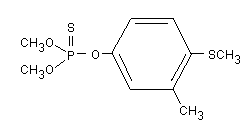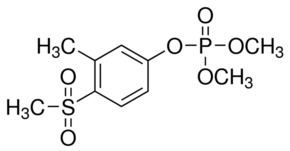Formula C10H15O3PS2 Boiling point 87 °C Density 1.25 g/cm³ | Molar mass 278.33 g/mol Melting point 7 °C Classification Organothiophosphate | |
 | ||
Appearance colorless, almost odorless liquid; 95-98% pure fenthion is a brown oily liquid with a weak garlic odor | ||
Fenthion is an organothiophosphate insecticide, avicide, and acaricide. Like most other organophosphates, its mode of action is via cholinesterase inhibition. Due to its relatively low toxicity towards humans and mammals, fenthion is listed as moderately toxic compound in U.S. Environmental Protection Agency and World Health Organization toxicity class.
Contents
- Uses
- Synthesis
- Health effects
- Acute toxicity
- Chronic toxicity
- Environmental effects
- Degradation in nature
- References

Uses

Fenthion is a contact and stomach insecticide used against many biting insects. It is particularly effective against fruit flies, leaf hoppers, cereal bugs, stem borers, mosquitoes, animal parasites, mites, aphids, codling moths, and weaver birds. It has been widely used in sugar cane, rice, field corn, beets, pome and stone fruit, citrus fruits, pistachio, cotton, olives, coffee, cocoa, vegetables, and vines.

Based on its high toxicity on birds, fenthion has been used to control weaver birds and other pest-birds in many parts of the world. Fenthion is also used in cattle, swine, and dogs to control lice, fleas, ticks, flies, and other external parasites.

Amid concerns of harmful effects on environment, especially birds, Food and Drug Administration no longer approves uses of fenthion. However, fenthion has been extensively used in Florida to control adult mosquitoes. After preliminary risk assessments on human health and environment in 1998 and its revision in 1999, USEPA issued an Interim Reregistration Eligibility Decision (IRED) for fenthion in January 2001. The EPA has classified fenthion as Restricted Use Pesticide (RUP), and warrants special handling because of its toxicity.

Some common trade names for fenthion are Avigel, Avigrease, Entex, Baytex, Baycid, Dalf, DMPT, Mercaptophos, Prentox, Fenthion 4E, Queletox, and Lebaycid. Fenthion is available in dust, emulsifiable concentrate, granular, liquid concentrate, spray concentrate, ULV, and wettable powder formulations.
Synthesis
Fenthion can be synthesized by condensation of 4-methylmercapto-m-cresol and dimethylphosphorochloridothionate.
Health effects

Fenthion exposure to general population is quite limited based on its bioavailability. Common form of fenthion exposure is occupation related, and occurs through dermal contact or inhalation of dust and sprays. Another likely means of contamination is through ingestion of food, especially, if it has been applied quite recently with fenthion. So far, ingestion is the most likely severe poisoning case on humans and animals. To avoid this, crops applied with fenthion should be allowed enough degradation time before harvesting. Normally, 2 – 4 weeks time is enough depending upon the type of crop.
Fenthion poisoning is consistent with symptoms of other organophosphate effects on human health. Primarily, the effect is cholinesterase inhibition.
Acute toxicity
Acute poisoning of fenthion results in miosis (pinpoint pupils), headache, nausea/vomiting, dizziness, muscle weakness, drowsiness, lethargy, agitation, or anxiety. If the poisoning is moderate or severe, it results in chest tightness, breathing difficulty, hypertension, abdominal pain, diarrhea, heavy salivation, profuse sweating, or fasciculation.
Chronic toxicity
Chronic effect of fenthion has not been reported.
Environmental effects
Despite short half-life in the environment, fenthion toxicity is highly significant to birds and estuarine/marine invertebrates. Even though some parts of the world use fenthion to control pest birds, such as weaver bird, many non-targeted wild birds are victim of fenthion poisoning. Acute symptoms of fenthion poisoning in birds include tearing of the eyes, foamy salivation, lack of movement, tremors, congestion of the windpipe, lack of coordination in walking, and an abnormally rapid rate of breathing or difficult breathing. Fenthion has been found toxic to fishes and other aquatic invertebrates. Bees are also found to be greatly affected by fenthion contamination.
Degradation in nature
Photodegradation and biodegradation are common mechanisms of fenthion degradation in the environment. In the atmosphere, vapor phase fenthion reacts rapidly with photochemically produced hydroxyl radicals, and its half-life is about 5 hours. In soil and water, photodegradation is again predominant mechanism if there is enough presence of sunlight. Under normal aquatic environment, half-life of fenthion in water is 2.9 to 21.1 days. It may be photodynamically, chemically or biologically degraded. The degradation mechanisms can be hydrolysis, oxidation, and/or alkylation-dealkylation, which are dependent on the presence of light, temperature, alkali, or enzymatic activity.
In soil, fenthion degradation ranges from 4 to 6 weeks and it occurs through photodegradation as well as anaerobic or non-photolytic organisms. However, soil particles strongly adsorb fenthion that makes it less susceptible to percolate with water through the soil.
